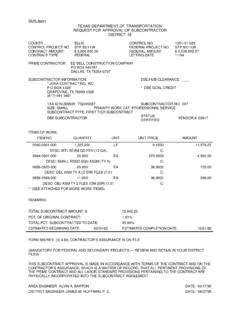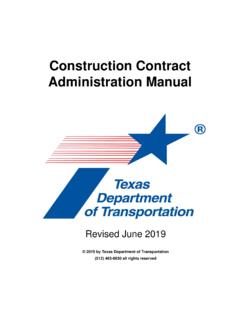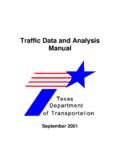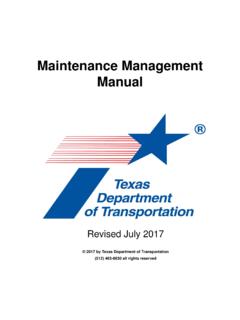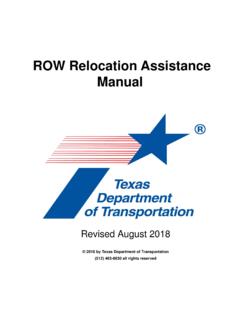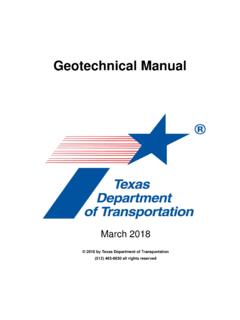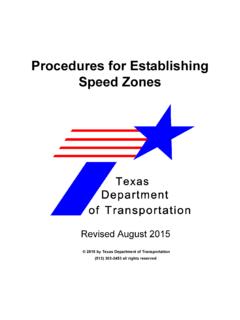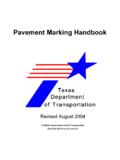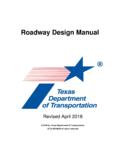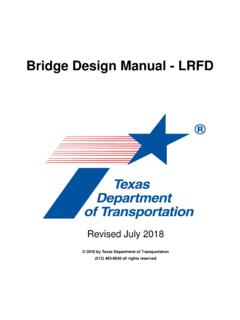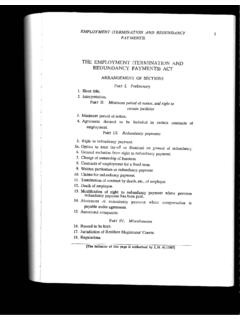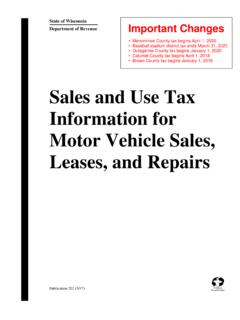Transcription of Bridge Railing Manual (RLG) - Texas Department of ...
1 Bridge Railing ManualJuly 2020 2020 by Texas Department of Transportation(512) 463-8630 all rights reservedManual Notice 2020-1 From:Graham Bettis, , Director, Bridge DivisionManual: Bridge Railing ManualEffective Date:July 13, 2020 PurposeThis Manual summarizes current policies governing the use of Bridge Railing in Texas , and it provides information on acceptable Texas Bridge Railing revisions in this version modified the requirement for TL-4 and removed Railing types T4, T6, C6, T101 and C101 from the Acceptable Railing No Longer Used for New Construction table. These rails are no longer deemed more information about this update, contact the Bridge Manual notices are available in a pdf Railing Manuali TxDOT 7/2020 Table of ContentsChapter 1 About This ManualSection 1 Overview .. 1-2 Purpose .. 1-2 Organization .. 1-2 Feedback .. 1-2 Chapter 2 Policies on Use of Bridge Railing for Vehicular TrafficSection 1 Overview .. 2-2 Introduction.
2 2-2 Definitions .. 2-2 Section 2 FHWA Policy on Bridge Railing .. 2-3 Overview .. 2-3 Historic FHWA Policy on Bridge Railing .. 2-4 Certifying Reimbursement-Eligible Roadside Safety Hardware.. 2-5 Required Crash Tests .. 2-5 Section 3 Texas Policy on Bridge Railing .. 2-7 Overview .. 2-7 Approval of Bridge Railing .. 2-7 Rail Type Selection .. 2-7 Metal Beam Guard Fence to Bridge Railing Transitions .. 2-8 Protecting the Ends of Bridge Railing .. 2-8 Railing on Bridge -Class Culverts .. 2-8 Railing on Roadways Elevated by Retaining Walls .. 2-9 Sound Barriers .. 2-10 Decorative Fencing .. 2-10 Chapter 3 Pedestrian, Bicycle, and ADA Requirements for Bridge RailingSection 1 Overview .. 3-2 Introduction .. 3-2 Section 2 Bridge Railing for Pedestrians .. 3-3 FHWA Policy .. 3-3 Texas Policy.. 3-3 Section 3 Bridge Railing for Bicyclists.. 3-5 Texas Policy.. 3-5 Section 4 ADA Requirements for Bridge Railing .. 3-6 Americans with Disabilities Act (ADA) Railing Requirements.
3 3-6 Handrails .. 3-6 Bridge Railing Manualii TxDOT 7/2020 Chapter 4 Treatment of Existing RailingSection 1 Overview .. 4-2 Introduction .. 4-2 Section 2 Bridge Railing Upgrade Requirements .. 4-3 FHWA Policy .. 4-3 Texas Policy.. 4-3 Existing Railing Meeting Current Standards (NCHRP Report 350) .. 4-5 Minimum Bridge Railing Height.. 4-7 Measuring Bridge Railing Height .. 4-8 Bridge Railing Height in Pavement Overlay Projects .. 4-8 Transition Upgrades.. 4-9 Recommendations .. 4-9 Section 3 Railing on Historic Bridges.. 4-11 Additional Guidelines .. 4-11 Historic Bridge Railing Options .. 4-11 Section 4 Bridge Railing Design Exceptions .. 4-12 Possible Design Exception .. 4-12 Chapter 5 Temporary Bridge RailingSection 1 Overview .. 5-2 Introduction .. 5-2 Policy .. 5-2 Selection of Temporary Barrier or Railing .. 5-2 Section 2 Temporary Railing .. 5-3 Precast Concrete Safety-shaped Traffic Barriers.. 5-3 Steel Traffic Barriers.
4 5-3 Appendix A Current Standard Bridge Railings in TexasSection 1 Overview ..A-2 Introduction .. A-2 More Information..A-2 Section 2 Metal Railing .. A-3 Traffic Railing Type T131RC .. A-3 Traffic Railings Type T631 and T631LS .. A-4 Pedestrian Railing Type PR11.. A-5 Section 3 Metal and Concrete Railing .. A-6 Traffic Railing Type T1F.. A-6 Traffic Railing Type T1P.. A-7 Traffic Railing Type T2P.. A-8 Bridge Railing Manualiii TxDOT 7/2020 Traffic Railing Type T1W .. A-9 Traffic Railing Type T402.. A-10 Traffic Railing Type T80HT .. A-11 Traffic Railing Type C2P .. A-12 Combination Railing Type C1W .. A-13 Combination Railing Type C221.. A-14 Combination Railing Type C223.. A-15 Combination Railing Type C402.. A-16 Combination Railing Type C66.. A-17 Pedestrian Railing Type PR22.. A-18 Pedestrian Railing Type PR3.. A-19 Section 4 Concrete Railing .. A-20 Traffic Railing Type T221.. A-20 Traffic Railing Type T222.. A-21 Traffic Railing Type T221P.
5 A-22 Traffic Railing Type T223.. A-23 Traffic Railing Type T224.. A-24 Traffic Railing Type T411.. A-25 Traffic Railing Type T551.. A-26 Traffic Railing Type T552.. A-27 Traffic Railing Type T66.. A-28 Traffic Railing Type SSTR .. A-29 Traffic Railing Type T80SS .. A-30 Traffic Railing Type C411.. A-31 Traffic Railing Type C412.. A-32 Traffic Railing Type T80TT .. A-33 Section 5 Bridge Rail Type Selection Guidance.. A-34 Introduction .. A-34 Summary of Bridge Rails by Test Level .. A-34 Bridge Rail Categories.. A-34 Considerations ..A-35 Appendix B Acceptable Placement of Bridge Railing for Vehicular and Non-vehicular TrafficSection 1 Overview .. B-2 Introduction .. B-2 Section 2 Placement of Bridge Railing .. B-3 Bridges Carrying Vehicular Traffic Only .. B-3 Bridges Carrying Vehicular and Non-vehicular Traffic - Low Speed Facilities.. B-3 Bridges Carrying Vehicular and Non-vehicular Traffic - High Speed Facilities .. B-4 Bridge Carrying Non-vehicular Traffic Only.
6 B-4 Bridge Railing Manual1-1 TxDOT 07/2020 Chapter 1 About This ManualContents:Section 1 OverviewBridge Railing Manual1-2 TxDOT 07/2020 Chapter 1 About This ManualSection 1 OverviewSection 1 OverviewPurposeThis Manual documents policy on the use of Bridge Railing in Texas and provides guidance on selection of Railing . The Manual is intended for use by Texas Department of Transportation (TxDOT) District and Division personnel and consultants employed by information in this Manual is organized as follows: Chapter 1, "About this Manual ." Introductory information on the purpose and organization of the Manual . Chapter 2, Policies on the Use of Bridge Railing for Vehicular Traffic. Current federal and state policy on use of Bridge Railing for vehicular traffic. Chapter 3, Pedestrian, Bicycle, and ADA Requirements for Bridge Railing . Policies for selecting Bridge Railing that meets needs of non-vehicular traffic. Chapter 4, Treatment of Existing Railing .
7 Policy and recommendations for upgrading existing Bridge Railing to current standards. Chapter 5, Temporary Bridge Railing . Policy for selecting Bridge Railing for temporary use during widening or other construction on existing bridges. Appendix A, Current Standard Bridge Railings in Texas . Descriptions and profile drawings of approved Bridge railings for use in new construction in Texas and guidance on selection of Bridge rail type. Appendix B, Acceptable Placement of Bridge Railing for Vehicular and Non-vehicular Traffic. Descriptions and drawings of Bridge Railing placement. FeedbackDirect any questions or comments on the content of the Manual to the Director of the Bridge Division, Texas Department of Railing Manual2-1 TxDOT 07/2020 Chapter 2 Policies on Use of Bridge Railing for Vehicular TrafficContents:Section 1 OverviewSection 2 FHWA Policy on Bridge RailingSection 3 Texas Policy on Bridge RailingBridge Railing Manual2-2 TxDOT 07/2020 Chapter 2 Policies on Use of Bridge Railing for Vehicular TrafficSection 1 OverviewSection 1 OverviewIntroductionThis chapter describes the federal and state policies for using Bridge Railing on bridges, Bridge -class culverts carrying vehicular traffic, and on roadways elevated by retaining walls, including.
8 Crash-testing requirements Approval of Bridge Railing Rail type selection Allowable uses of Bridge Railing for specific installationsWhen a structure includes non-vehicular traffic, either alone or in combination with vehicular traffic, other requirements must be satisfied. See Chapter 3, Pedestrian, Bicycle, and ADA Requirements for Bridge Railing , for these railings are classified for use according to the following definitions: Traffic Railing - a Railing that has been successfully crash-tested to current test criteria, which is used adjacent to vehicular railings are titled with a "T" prefix. Pedestrian Railing - a Railing used adjacent to a pedestrian walkway, which has specific height and opening requirements. Railings in this Manual and the TxDOT Bridge Division Bridge Standards that are titled "Pedestrian" (a "P" prefix) have not been crash-tested and cannot be used adjacent to vehicular traffic. Combination Railing - a traffic Railing that also satisfies the height and opening requirements of a pedestrian Railing .
9 Combination railings are titled with a "C" chapter addresses Bridge railings that are classified as traffic Railing and combination Railing , when used with vehicular traffic. See Chapter 3, "Pedestrian, Bicycle, and ADA Requirements for Bridge Railing ," for use of pedestrian and combination Railing with non-vehicular Railing Manual2-3 TxDOT 07/2020 Chapter 2 Policies on Use of Bridge Railing for Vehicular TrafficSection 2 FHWA Policy on Bridge RailingSection 2 FHWA Policy on Bridge RailingOverviewOn August 28, 1986, Mr. Morgan, the Federal Highway Administration s (FHWA) Executive Director at that time, issued a policy memorandum that stated highway bridges on the National Highway System (NHS) and the Interstate Highway System (IHS) must have crash-tested then, there have been numerous policy memorandums and reports issued by FHWA, the American Association of State Highway Officials (AASHTO) and the National Cooperative Highway Research Program (NCHRP) regarding Bridge Railing safety.
10 Federal laws have also been passed that include measures to enhance the crash worthiness of roadside features. Current policy is stated in the following documents: FAST Act, Fixing America s Surface Transportation Act (Pub. L. No. 114-94), was signed into law by President Obama on December 4, 2015. The first federal law in over a decade, the FAST Act authorizes $305 billion over Fiscal Years 2016 through 2020 for highway, highway and motor vehicle safety, public transportation, motor carrier safety, hazardous materials safety, rail, and research, technology, and statistics programs. Recording and Coding Guide for the Structure Inventory and Appraisal of the Nation s Bridges. Report No. FHWA-PD-96-001, p. 69 (1995). Clarifies that safety feature replacement or upgrading (for example, Bridge ) is a type of work eligible for funding under any of the Federal aid categories but not considered as reconstruction and, therefore, not activating the FHWA s Ten Year Rule.
